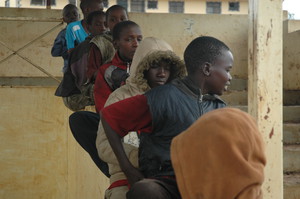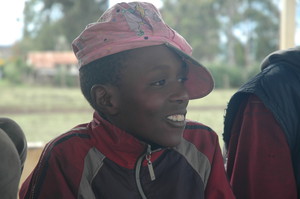12 Young Street Boys Rescued by Ndugu Mdogo
 Twelve young Street Boys aged between 5-14 years were on May 10 rescued from the street of Nairobi and are currently undergoing rehabilitation at Ndugu Mdogo Rescue Centre.
Twelve young Street Boys aged between 5-14 years were on May 10 rescued from the street of Nairobi and are currently undergoing rehabilitation at Ndugu Mdogo Rescue Centre.
The street boys had earlier been identified by Koinonia Social workers and were scheduled to be rescued from the street and taken to the centre for rehabilitation. The Rescue Centre targets to rehabilitate at least 20 street children per year. The workers always have to devise ways to reach out to theses children and gradually befriend them, which they do over a period of about one month. This is because many are fearful of street children and look upon them as criminals, due in part to their increasingly bold begging and extortion techniques. Consequently, the street children display apathy to the social workers’ overtures.
The social workers endeavour to deepen their newfound bond with the identified children by engaging in various activities with them. On the said date, the children were taken for breakfast by the social workers in Ngong town and later headed to Ngong Stadium where they played football.
Interviews with the children revealed the harrowing experiences that earlier took them to the streets.
 B.K, 14, hails from Kitengela a small town in the outskirts of Nairobi. In a brown hooded jacket, Kuria is silent in most parts of the street activities. The look in his eyes shows he is deep in thought. Speaking to him he gives an accounts of how it was being was a standard seven pupil at Jamii Bora Primary School in Soweto. He however dropped out of school due to being suspended for truancy. Consequently he left home for the streets. He speaks of his school days with nostalgia and a year down the line he says he wants to go for rehabilitation and eventually go back to school. “The street life is not good…not good at all, you are always on the run from the police and people who think of you as a criminal” he speaks as he shifts his legs exposing his dirt soiled pants and mud covered rubber shoes. He would go to dumpsites and dustbins around Soweto picking metal, which he would later sell to scrap metal dealers at Ksh 25 per kilo of the scrap metal. He would use the money acquired to buy glue or plane engine oil at Ksh 5 per bottle top to sniff. He said they use glue and other drugs to heighten their senses to alert them of possible violence, facilitate sleep during the cold nights, or to numb their physical or emotional pain.The rest of the meager money he would split it between food and clothing.
B.K, 14, hails from Kitengela a small town in the outskirts of Nairobi. In a brown hooded jacket, Kuria is silent in most parts of the street activities. The look in his eyes shows he is deep in thought. Speaking to him he gives an accounts of how it was being was a standard seven pupil at Jamii Bora Primary School in Soweto. He however dropped out of school due to being suspended for truancy. Consequently he left home for the streets. He speaks of his school days with nostalgia and a year down the line he says he wants to go for rehabilitation and eventually go back to school. “The street life is not good…not good at all, you are always on the run from the police and people who think of you as a criminal” he speaks as he shifts his legs exposing his dirt soiled pants and mud covered rubber shoes. He would go to dumpsites and dustbins around Soweto picking metal, which he would later sell to scrap metal dealers at Ksh 25 per kilo of the scrap metal. He would use the money acquired to buy glue or plane engine oil at Ksh 5 per bottle top to sniff. He said they use glue and other drugs to heighten their senses to alert them of possible violence, facilitate sleep during the cold nights, or to numb their physical or emotional pain.The rest of the meager money he would split it between food and clothing.
 J.K, 14, hails from Umoja in Nairobi. Dressed in a red jacket, and yellow plastic flip flops Joe narrates of how he was always beaten up at home and yet again in school. In a pensive tone he remembers how a certain teacher in his school would always punish him at the expense of others. He pauses and says “I was suspended...it was way too much for me…so I ran away!” the former standard six pupil of Kifaru primary School found a new home under the Donholm bridge where he was accepted by other street boys. “It was hard…really hard…at times food was hard to come by…” he chips in with a shy smile on his face. “I can’t believe it that I will not worry about that life again…thank you God, thank you teacher Jack (one of the social workers)”.
J.K, 14, hails from Umoja in Nairobi. Dressed in a red jacket, and yellow plastic flip flops Joe narrates of how he was always beaten up at home and yet again in school. In a pensive tone he remembers how a certain teacher in his school would always punish him at the expense of others. He pauses and says “I was suspended...it was way too much for me…so I ran away!” the former standard six pupil of Kifaru primary School found a new home under the Donholm bridge where he was accepted by other street boys. “It was hard…really hard…at times food was hard to come by…” he chips in with a shy smile on his face. “I can’t believe it that I will not worry about that life again…thank you God, thank you teacher Jack (one of the social workers)”.
The other ten boys had more or less the same tale. A similar pattern can be noted. Most often, the child experienced hostile conditions either at home or at school, and opted for the streets as a way to escape from the unfriendly environment. The social workers before the rescue visited the children’s homes of origin. Incidentally, most of the children actually have parents or guardians, but seek to escape from certain unfriendly situations. These visits give the workers an actual glimpse of the real reason for the child’s sojourn on the street, which may vary from abject poverty to abuse by alcoholic parents or guardians among other possible reasons. During these visits, the workers reach out to the parents in view of the child’s rehabilitation. Where the parents or guardians have personal problems that strain their relationship with the child, the social workers try to counsel them into supporting the child’s rehabilitation process as much as they can.
After leaving the Stadium, the Social workers took the children for a hearty lunch of meat, soda and Ugali. After which clothes and shoes for the children were purchased in Ngong town. Excitement was written all over the children’s faces when they were told that all the new, clean clothes were theirs.
The children were later taken into their new secure home. The Ndugu Mdogo Rescue Centre at Nairobi’s Kibera slum. The hope in their faces was tenfold. They took a shower, shed off their old, tattered lice infested clothes and wore new clean clothes. This marked their transition from the street life into a new rehabilitated life. The 12 former street Children are now on their way into being new members of the society that earlier sunned and feared them. The one year rehabilitation ends in either December/January: This month marks the end of the rehabilitation programme. The social workers carry out an assessment of the child’s family to determine the stability of the home environment and capacity to provide for the child’s basic needs and stationery for impending school placement. Where the situation is favourable, the child is reintegrated back into the family at this point, but in cases where further fostering is required, the child is either considered for admission to the main Ndugu Mdogo Home at Kerarapon or referred to another rehabilitation centre.
The United Nations has defined the term ‘street children’ to include “any boy or girl… for whom the street in the widest sense of the word … has become his or her habitual abode and/or source of livelihood, and who is inadequately protected, supervised, or directed by responsible adults.” Street children are also divided into two groups: those who live IN the street (spend all their time in the street), and those who live ON the street (those who return home at night). Street Children in Kenya are a by-product of global economic recession, rapid globalization, rising cost of living, social disintegration, AIDS pandemic, structural adjustment programs, and increasing poverty and urbanization. Street children and young mothers have become part of the landscape in most Kenyan cities and towns. It is difficult to establish the exact number of street children in Kenya and Nairobi in particular. It is estimated that about 250,000 – 300,000 street children with more than 60,000 of them in Nairobi. Shanty towns like Kibera and Korogocho are home for some of these children.
The Ndugu Mdogo Rescue Centre launched operations in September 2005.The Centre provides a base for academic research on street life, which is carried out with support from various universities. The Centre also responds to emergencies resulting from street violence, disease, exploitation and drugs-related issues. The Centre can accommodate up to ten children for emergencies like sickness, abuse by adults and immediate danger. The Rescue Centre also supports initiatives to empower street youth using available resources in recycling and conservation of the environment. This project makes use of their acquired life skill, resulting in the setting up of a recycling unit for plastics, alongside other useful activities in support of environmental conservation.



